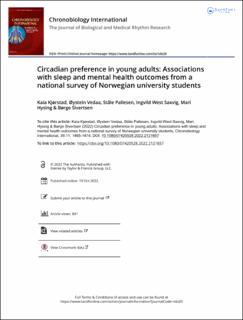| dc.contributor.author | Kjørstad, Kaia | |
| dc.contributor.author | Vedaa, Øystein | |
| dc.contributor.author | Pallesen, Ståle | |
| dc.contributor.author | Saxvig, Ingvild W. | |
| dc.contributor.author | Hysing, Mari | |
| dc.contributor.author | Sivertsen, Børge | |
| dc.date.accessioned | 2022-12-12T13:55:11Z | |
| dc.date.available | 2022-12-12T13:55:11Z | |
| dc.date.created | 2022-11-04T13:05:33Z | |
| dc.date.issued | 2022 | |
| dc.identifier.issn | 0742-0528 | |
| dc.identifier.uri | https://hdl.handle.net/11250/3037313 | |
| dc.description.abstract | Individual preferred timing of sleep and activity patterns, known as circadian preference, ranges from definitely morning types to definitely evening types. Being an evening type has been linked to adverse sleep and mental health outcomes. This study aimed to explore the associations between circadian preference and self-reported sleep, depression, anxiety, quality of life, loneliness, and self-harm/suicidal thoughts. Data stem from a national survey of students in higher education in Norway (the SHoT-study). All 169,572 students in Norway were invited to participate, and 59,554 students (66.5% women) accepted (response rate = 35.1%). Circadian preference was associated with sleep and mental health outcomes in a dose–response manner. For both genders, being an evening type (either definitely evening or more evening than morning) was associated with an increase in age-adjusted relative risk (RR-adjusted; range = 1.44 to 2.52 vs. 1.15 to 1.90, respectively) across all outcomes compared with definitely morning types. Overall, the present study provides further evidence that evening circadian preference is associated with adverse sleep and mental health outcomes in young adults. As such, future efforts to improve sleep and mental health in young adults should consider their circadian preferences. | en_US |
| dc.language.iso | eng | en_US |
| dc.publisher | Taylor & Francis | en_US |
| dc.rights | Navngivelse 4.0 Internasjonal | * |
| dc.rights.uri | http://creativecommons.org/licenses/by/4.0/deed.no | * |
| dc.title | Circadian preference in young adults: Associations with sleep and mental health outcomes from a national survey of Norwegian university students | en_US |
| dc.type | Journal article | en_US |
| dc.type | Peer reviewed | en_US |
| dc.description.version | publishedVersion | en_US |
| dc.rights.holder | Copyright 2022 The Author(s) | en_US |
| cristin.ispublished | true | |
| cristin.fulltext | original | |
| cristin.qualitycode | 1 | |
| dc.identifier.doi | 10.1080/07420528.2022.2121657 | |
| dc.identifier.cristin | 2069209 | |
| dc.source.journal | Chronobiology International | en_US |
| dc.source.pagenumber | 1465-1474 | en_US |
| dc.identifier.citation | Chronobiology International. 2022, 39 (11), 1465-1474. | en_US |
| dc.source.volume | 39 | en_US |
| dc.source.issue | 11 | en_US |

